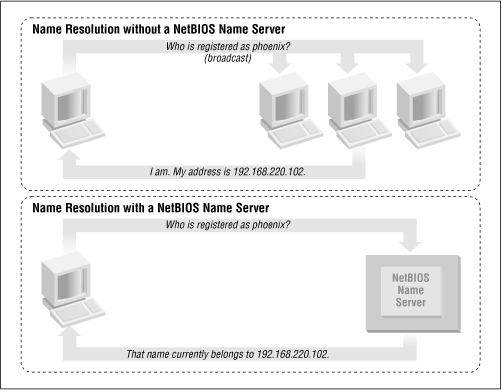For a human being, getting a name is easy. However, for a machine on a NetBIOS network, it can be a little more complicated. Let's look at a few of the issues.
In the NetBIOS world, when each machine comes online, it wants to claim a name for itself; this is called
name registration. However, no two machines in the same workgroup should be able to claim the same name; this would cause endless confusion for any machine that wanted to communicate with either machine. There are two different approaches to ensuring that this doesn't happen:
Figure 1.8 illustrates a (failed) name registration, with and without a NetBIOS Name Server.

In addition, there must be a way to resolve a NetBIOS name to a specific IP address as mentioned earlier; this is known as
name resolution. There are two different approaches with NBT here as well:
Figure 1.9 illustrates the two types of name resolution.

As you might expect, having an NBNS on your network can help out tremendously. To see exactly why, let's look at the non-NBNS method.
Here, when a client machine boots, it will broadcast a message declaring that it wishes to register a specified NetBIOS name as its own. If nobody objects to the use of the name after multiple registration attempts, it keeps the name. On the other hand, if another machine on the local subnet is currently using the requested name, it will send a message back to the requesting client that the name is already taken. This is known as
defending the hostname. This type of system comes in handy when one client has unexpectedly dropped off the network - another can take its name unchallenged - but it does incur an inordinate amount of traffic on the network for something as simple as name registration.
With an NBNS, the same thing occurs, except that the communication is confined to the requesting machine and the NBNS server. No broadcasting occurs when the machine wishes to register the name; the registration message is simply sent directly from the client to NBNS server and the NBNS server replies whether or not the name is already taken. This is known as
point-to-point communication, and is often beneficial on networks with more than one subnet. This is because routers are often preconfigured to block incoming packets that are broadcast to all machines in the subnet.
The same principles apply to name resolution. Without an NBNS, NetBIOS name resolution would also be done with a broadcast mechanism. All request packets would be sent to each computer in the network, with the hope that one machine that might be affected will respond directly back to the machine that asked. At this point, it's clear that using an NBNS server and point-to-point communication for this purpose is far less taxing on the network than flooding the network with broadcasts for every name resolution request.
